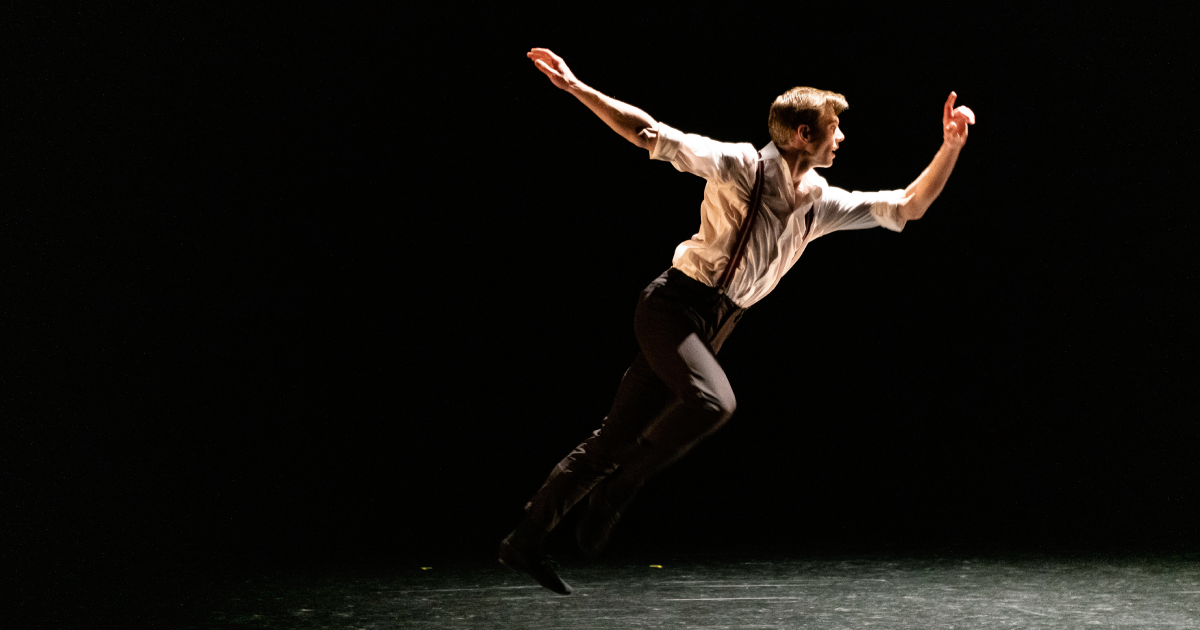Dance performed to live music is one of life’s great joys, and Grand Rapids Ballet’s “Jumpstart 2024” celebrates the marvelous musicality of their dancers as well as what’s possible when collaboration between composers and choreographers, musicians and dancers come together.
The annual Jumpstart performance is a fan favorite. Featuring new choreography from the company dancers, it’s often an eclectic mix that offers a wonderful variety of dances. This year’s “Jumpstart 2024” takes this annual collaboration to a new level. With only two weeks rehearsal, they’ve produced 12 brand new works set to live music from a diversity of local musicians who share the stage with the dancers.
This two-and-a-half hour performance in two acts showcases the tremendous talent, technical skill, creative innovation, and tremendous expressivity of the company as well as that of the local musicians with whom they collaborated to create this exciting show.
Several of the most powerful of the pieces are pas de deux in which the music, movement, and expressivity are matched elegantly and in intensity. In Jacy Klein’s highly sensual pas de deux “Perfect Harmony”, featuring music by Sergei Prokofiev performed by pianist Justin Gray and violinist Gene Hahn, Nathan Young chases, lifts, and partners Rowan Allegra exquisitely. It is a perfect balance, indeed.
Similarly, Sam Epstein’s pas de deux “Marietta’s Lied” with operatic music by Erich Wolfgang Korngold performed by pianist Ryan Blok and singer Alexandra Galla, is a pas de deux full of very intimate connections, both physical and emotional, with beautiful lifts as well as lovely floor work from dancers Anderson Da Silva and Sarah Marley. And Rowan Allegra’s dramatic “Énouement”, set to Ryan Blok’s original piano composition, explores disconnection through intense physical connection. Full of marvelous lifts, turns, and leaps, Nathan Young literally carries on his back Yuka Oba-Muschiana onto and off the stage, a metaphor for the way a relationship feels at its completion.
Many of the other dances are also romantic but shot through with whimsy, from Claudia Rhett’s light, joyful pas de trois “Sunday in the Park” to Tristan Toy’s “Over the Moon”, a sweet series of pas de deux that captures the delights of new relationship energy to Ashley Rosendahl’s “Corner of Belles Artes”, an exuberant set of street scenes driven by Michael Schafer’s stylish, passionate accordion playing.
Also joyful if not downright jubilant is Nathan Young’s “Banish Misfortune”, a nicely-crafted, Celtic folk dance in which seven dancers move in variations from lines to circles with a romantic pas de deux amid the grander ceili. With Irish-inflected music from duo Keala Venema and Thom Jayne (known as Whorled) that varies from fiddle and guitar to tin whistle and didgeridoo, it’s a grand, festive triumph.
Other dances push the envelope in terms of both choreography and music, exploring darker themes and less traditional or classical movement. Ritsu Katsumata composed an original work on synthesized electric violin and digital loops that reverberates the emotions of Julian Gan’s both lovely and unnerving “Fractures of the Mind”. Isaac Lee grapples with the dichotomy of isolation and connectivity both literally and figuratively through movement in “A Dissociated Connection” set to spoken word performed by Amanda Smalls. “There is no greater power than the power of now,” she says as the nine dancers prove the point with their elegant performance, presence, and surprising musicality despite moving to spoken word rather than melodies.
From classical to folk to rock, the variety of music matches the diversity of movement. The grand finale required an interview with two choreographers opening night to allow time for The American Hotel System to set up their guitars and drum kit for William Wisneskey’s “Can You Hear It?”, the biggest number of the night, featuring 19 dancers and two distinct songs from the band. Sound levels were off so the vocals were drowned out by the drums, but the inspirational melodies and big chords enhanced the grand lifts and outstretched arms, joyful movements and an exuberant rock and roll pas de trois wherein the woman is repeatedly lifted, twirled, and tossed in the air. Much of the rest of the choreography felt disorganized and cluttered, but the intended emotion, it seemed, was communicated despite the technical glitches.
And the enormity of the performance’s sum total more than makes up for any sound issues. “Jumpstart 2024” is the biggest and boldest of Grand Rapids Ballet’s annual offering of new works created by the dancers themselves. With a record 12 new works set to live, sometimes original music (and poems), often performed by the composers themselves, “Jumpstart 2024” is a celebration of the power of movement and live music as well as what terrifically ambitious local artists can create together.
Jumpstart 2024
Grand Rapids Ballet
March 22-24
https://grballet.com/2023-24-season/
Article by Marin Heinritz





